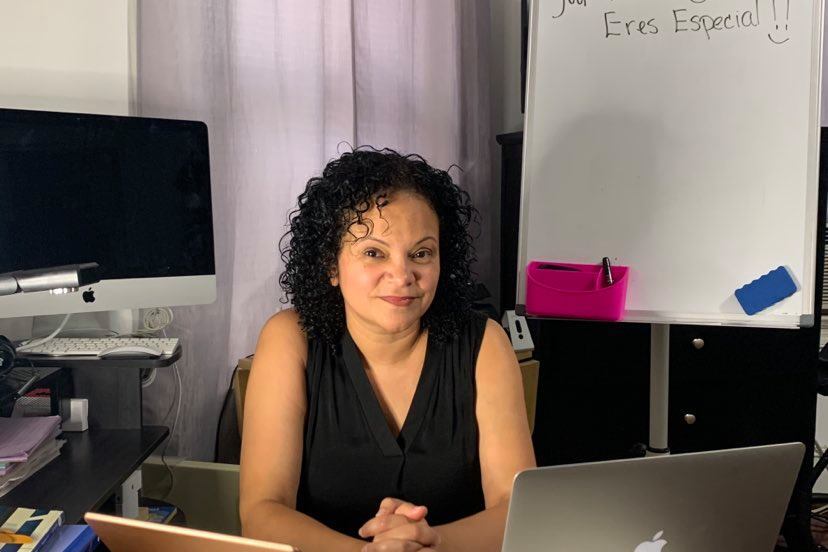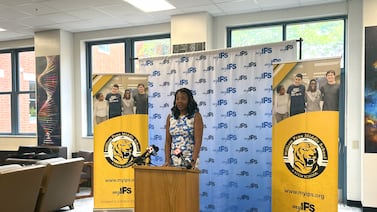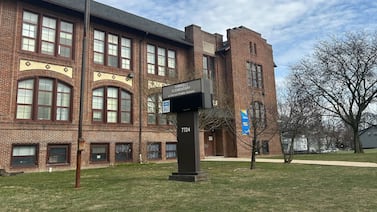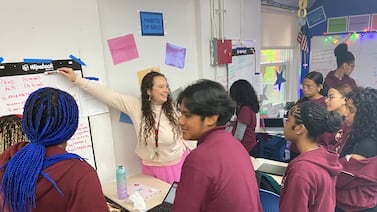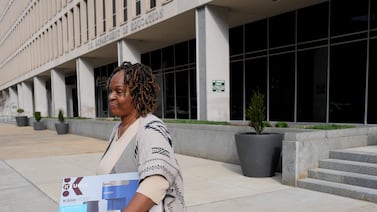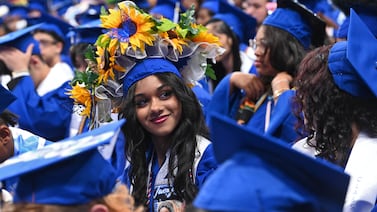Teaching is not just a job for Wirmarie Morales. It’s a calling answered by three generations of women in her family: her grandmother, her mother and three aunts, and her sister and her.
“It’s just in the blood,” said Morales, whose college-age daughter is also studying to become a teacher. “I think we’re just born with that vocation because all of us have been educators.”
Except for Morales’ grandmother, who taught in her native Puerto Rico, all the women chose to work in Newark schools. Morales has spent her 23-year career at Ridge Street School, where she is a fourth grade bilingual teacher.
The school holds special significance for her. She attended Ridge Street as a young child who spoke little English after her family relocated from Puerto Rico. She excelled in school, graduating from what is now Science Park High School before earning a bachelor’s and two master’s degrees from Kean University. Now working on a Ph.D., Morales credits Newark schools with setting her on a successful path.
“I had a great education,” said Morales, whose two younger children currently attend public schools in Newark. “I had teachers who always helped me find the best in me, and they always guided me.”
This year, the pandemic has forced even veteran educators like Morales to adapt.
She now gives virtual lessons from a walk-in closet in her North Ward home, where she set up a whiteboard, camera, and multiple computer screens. After school buildings closed in March, she began sending her students air hugs over video and holding online workshops in Spanish for parents. As families across Newark struggled with food and financial insecurity, Morales delivered groceries to her students’ homes and signed them up for free internet.
“It kind of made you a different kind of teacher,” she said. “It was just trying to make sure my kids were OK — that was my biggest worry.”
This interview has been edited for length and clarity.
What was it like for you as a student who was still learning English?
It was very difficult. At six years old, you’re still learning your language, and also adding another language on top of that.
My teachers were great and they always made available for me the same content, the same curriculum [as used in English-only classes]. And now I know as a bilingual teacher, sometimes those resources are not available all the time for bilingual students.
My mom would help me, my family members, but I was really on my own for a while navigating the language. You become a translator when you’re first generation here. All of those things do help in becoming a better speaker of any language, but it is hard on a child.
How has that experience influenced your work as a bilingual teacher?
It makes me a better teacher because it makes me more empathetic to what their needs are. I understand when a student walks into my classroom and they’re terrified because they just left their country and they’re in this whole brand-new world with this whole brand-new language.
I always tell them, “I was sitting where you are — literally. You can do much greater things than me.”
Shifting to last spring: What was it like having to teach remotely all of a sudden?
Once I was able to communicate with parents, we started the whole online remote learning. It was still a challenge.
For example, I had one student who called me in May crying. She said the servicing center for food had closed and she didn’t want to go hungry. And I would have realized if she was hungry or not in school, but online learning provided a different type of barrier.
I was able to communicate with her father. I found out he lost his job, so did the mom. They were struggling. So I went food shopping that afternoon to drop some groceries off at their house. And then we arranged for the city to deliver food.
It kind of made you a different kind of teacher. You’re always growing in this profession, this just added to it. It was just trying to make sure my kids were OK — that was my biggest worry.
How else has the pandemic affected your students and their families?
Many of my students, their families have lost jobs. I’ve had students who lost family members. There were students who were terrified and scared.
It has affected their learning. They’re not in front of me. I can’t meet their needs the way I would meet them in the classroom. Not because we’re not teaching them, but just because it’s different not to be in person and be on a Webex or a Zoom meeting.
Most of them are ready to go back. They’re like, “We want to go to school. We’re never going to wish for a snow day again.”
Has access to technology been a challenge for your students?
Technology is a big issue because a lot of my kids can’t afford a $200 Chromebook. And if there’s five or six siblings, one person’s using the Chromebook and everybody else has to wait.
In the spring, when this first occurred, maybe about five of my students out of 25 had a computer. Some were working off their phones. So I allowed kids to take pictures of their handwritten work and send it to me [until] the school started to give out Chromebooks.
I had students at that time going to Dunkin’ Donuts or Burger King trying to get internet access. I made calls for a few parents and helped them get internet. Thank god for Optimum, they provided free internet.
Now, in September, all my kids have a device.
What has this been like for students whose parents don’t speak English?
It’s been very hard for the parents.
I’ve done various FaceTime meetings with the parents or Zoom meetings. I literally shared my screen and explained everything to them: how to use Google Classroom, how to contact me through any of the apps, how to make sure their kids are actually handing in the work.
If these parents are trusting me to educate their children, then I want to give them as much respect as possible to be part of my team.
How do you create a classroom community when you’re separated from one another?
We use all the same rules, except they’re virtual. We respect each other, we give thumbs up, we raise our hand, we don’t interrupt. We keep our cameras on because I want to see your beautiful faces.
I still try to do the same morning activities — our air hugs, tell me a little bit about your day.
There’s days where the kids don’t want to leave, and I’m like, “Guys, it’s three, I have to go.” But they’re like, “Oh, but we want to show you our guinea pig.” So we still have the same kind of relationship we had in school.
What advice would you give new teachers?
I always tell the teachers that I’m training and mentoring that every child needs at least one person that is incredibly crazy about them. That’s all they need — one teacher to believe in them. With that belief, a child can aim for the stars.

